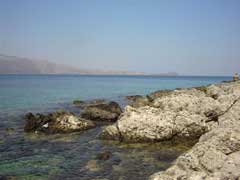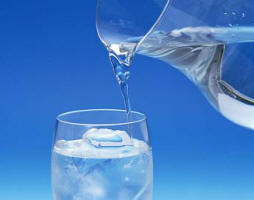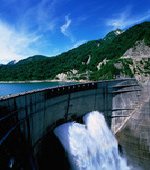 Iron as a new water "pollutant" in Central Germany
Iron as a new water "pollutant" in Central Germany
The River Pleisse, the major tributary of the River Weisse Elster in the
Central-German industrial region, used to be excessively polluted mainly by
industrial wastewater from coal-processing, textile, and leather industries
before the political change in 1989. Since then, anthropogenic pollution has
significantly decreased due to close-down of industrial plants and upgrading of
wastewater treatment plants. Nevertheless, the water in the lower course of the
river has remained turbid and brown. This causes concern in the city of Leipzig,
where efforts are made to reconvert the river branches and mill races that had
been canalized underground into open rivers and canals.
The cause of this
phenomenon is groundwater pumping in the large brown-coal open-cast mining
district south of the city. Quantity, quality, and locations of these
mine-drainage discharges are changing along with the operation and advance of
the mines. Groundwater that is drained from tertiary horizons, where marcasite
and pyrite are present, contains up to 80 mg/l of soluble iron. In the river,
the iron is rapidly oxidized, bound to particles of suspended matter, and
transported downstream. Previously, when the organic pollution was high, the
mine-drainage water with its high level of dissolved iron even had a purifying
effect. The iron then flocculated the suspended particulate matter and
precipitated it into sediment with a high content of
sapropel.
Sediments sampled between 1991 and 2008 upstream
of the mining area had iron contents between 4 and 5%. In the lower course of
the river, the iron levels ranged between 24% in 1991, 8% in 1994, 20% in 2004,
and 17% in 2008. The geogenic iron background level in floodplain
soils on the lower River Pleisse is 4.3 % (Müller et al. 2003). Since
iron is a common geogenic element it has accumulated with the mine drainage in
the lower course of the River Pleisse for long. Suspended particulate
matter, sampled between 2000 and 2008 in the lower course of the river
at Leipzig, contains 6 to 26 mg/kg iron. This corresponds to 2 to 69 mg/l total
iron. The wide variability is due to the fact that the sampling campaigns were
made during different hydrological events (flood, drought).
Most of the iron
in the river is particle-bound. That is why the total iron
content of the river water is influenced by the amount of suspended
solids in the water and by the concentration of iron on these particles. It
depends on direct inputs as well as on the hydrological situation. Heavy rain
erodes soils, and flood events mobilise old sediments (secondary sources), so
that concentration peaks may occur.
The mean daily iron load is 1.2 t/d,
during mean streamflow of 3.36 m³/s (gauged upstream of the mine-drainage input)
and with a total iron concentration of 1 mg/l. Since January 2007, the
mine-drainage inputs have been limited to 0.3 m³/s. This corresponds to an iron
load of 0.8 t/d, calculated with a mean concentration of 30 mg/l. So, the total
iron concentration in the river increases up to 3 mg/l downstream of the
mine-drainage input.
It is a paradox that the decrease in pollution in the
River Pleisse (heavy metals and organics) has also a negative side-effect. The
fine iron-oxide particles remain longer in suspension, so that the riverbed on
the whole lower course becomes covered with a brownish encrustation.
As a
consequence, the mine operators are planning to build a mine-drainage treatment
plant.
| Contact information |
Dr. Lutz Zerling, Christiane Hanisch; Saxonian Academy of Sciences, Leipzig – Germany.
(email: zerling@saw-leipzig.de; hanisch@saw-leipzig.de) |
|---|---|
| News type | Inbrief |
| File link | n/a |
| Source of information | SedNet |
| Subject(s) | ANALYSIS AND TESTS , CHARACTERISTICAL PARAMETERS OF WATERS AND SLUDGES , DRINKING WATER AND SANITATION : COMMON PROCESSES OF PURIFICATION AND TREATMENT , HEALTH - HYGIENE - PATHOGENIC MICROORGANISM , PREVENTION AND NUISANCES POLLUTION , SANITATION -STRICT PURIFICATION PROCESSES , WATER QUALITY |
| Geographical coverage | Germany |
| News date | 09/12/2008 |
| Working language(s) | ENGLISH , GERMAN |
 you are not logged in
you are not logged in





